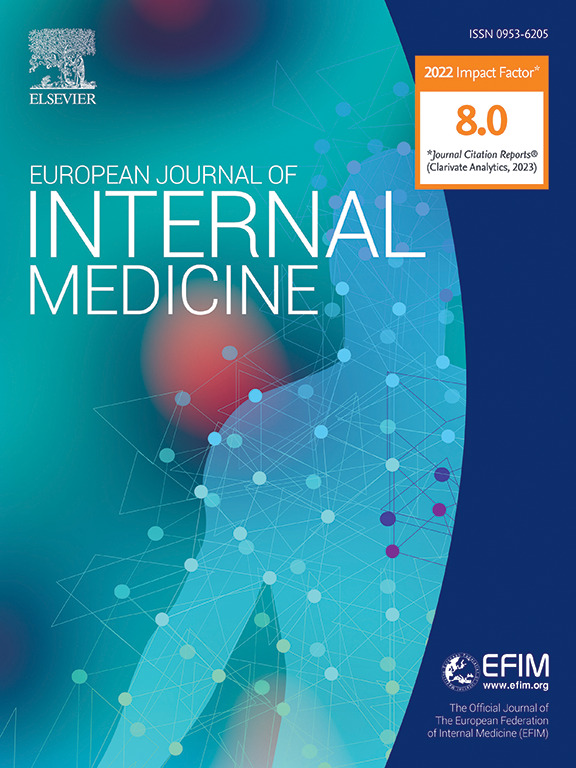Intermediate Care Units in Internal Medicine
IF 6.1
2区 医学
Q1 MEDICINE, GENERAL & INTERNAL
引用次数: 0
Abstract
Background
Intermediate Care Units (ImCU) have been historically described as an intermediate level of care between standard wards and intensive care units (ICU), and general medical ImCUs have evolved as specifically addressed to high care medical patients. The objective of this study is to explore designs, appropriateness criteria, and quality of care of general medical ImCUs.
Methods
a comprehensive literature search was performed in electronic database (PubMed/Medline, Embase, Cochrane and Web of Science) up to July 30th 2024 and data about general medical ImCU denominations, settings, processes and outcomes were extracted.
Results
34 studies were included in systematic analyses, the more used nomenclature was ImCU (70.6 %), followed by High Dependency Unit (20.6 %). The median number of beds was 8 [4–11], the nurse-to-patients ratio 1:3.1, and internists involved in comanagement in 40.0 %. Either a step-up from standard wards or a step-down from ICUs role were reported, with a median of 50.8 % [26.2–71.0] of patients directly admitted from Emergency Departments. The main distinctive activities were continuous monitoring and non-invasive ventilation. The median ICU transfer rate was 8.0 % [5.6–12.3], while in-ImCU and in-hospital mortality were 6.2 % [3.6–8.3] and 14.0 % [8.7–19.1], respectively.
Conclusions
general medical ImCUs are being increasingly recognized as the appropriate setting for high care medical patients but present to date a wide variability of formats. Activity-based admission criteria tailored on each hospital reality could be a process model for adequate patient flow, and quality of care key indicators should consider the functional general medical ImCU role in hospital macro-systems.
内科中级护理病房。
背景:中级护理病房(ImCU)在历史上被描述为介于标准病房和重症监护病房(ICU)之间的中间护理水平,而普通医疗ImCU已经发展为专门针对高护理医疗患者的护理。本研究的目的是探讨普通医学重症监护病房的设计、适宜性标准和护理质量。方法:全面检索电子数据库(PubMed/Medline、Embase、Cochrane和Web of Science)截至2024年7月30日的文献,提取一般医学ImCU的名称、设置、流程和结果等数据。结果:34篇文献被纳入系统分析,ImCU(70.6%)使用率最高,其次是High Dependency Unit(20.6%)。床位数中位数为8张[4-11],护患比为1:3.1,内科医生参与管理占40.0%。据报道,直接从急诊科入院的患者中,有50.8%[26.2-71.0]从标准病房升入或从icu降入。主要的特色活动是持续监测和无创通气。ICU转院率中位数为8.0%[5.6-12.3],在imcu和住院死亡率中位数分别为6.2%[3.6-8.3]和14.0%[8.7-19.1]。结论:普通医学重症监护病房越来越被认为是适合高护理医疗患者的环境,但迄今为止存在很大的格式差异。根据每家医院的实际情况量身定制的以活动为基础的入院标准可以作为充分的患者流量的过程模型,而护理质量关键指标应考虑功能性综合医疗ImCU在医院宏观系统中的作用。
本文章由计算机程序翻译,如有差异,请以英文原文为准。
求助全文
约1分钟内获得全文
求助全文
来源期刊
CiteScore
9.60
自引率
6.20%
发文量
364
审稿时长
20 days
期刊介绍:
The European Journal of Internal Medicine serves as the official journal of the European Federation of Internal Medicine and is the primary scientific reference for European academic and non-academic internists. It is dedicated to advancing science and practice in internal medicine across Europe. The journal publishes original articles, editorials, reviews, internal medicine flashcards, and other relevant information in the field. Both translational medicine and clinical studies are emphasized. EJIM aspires to be a leading platform for excellent clinical studies, with a focus on enhancing the quality of healthcare in European hospitals.

 求助内容:
求助内容: 应助结果提醒方式:
应助结果提醒方式:


